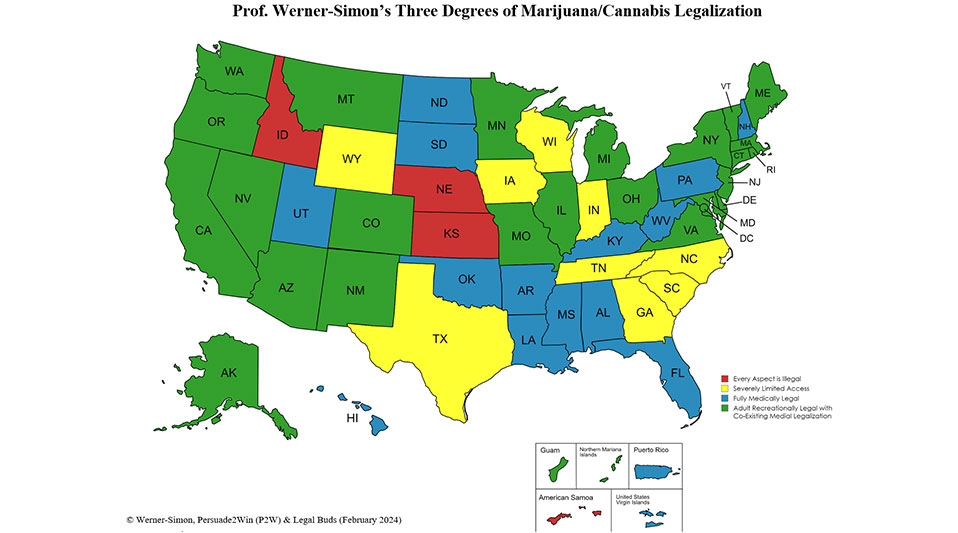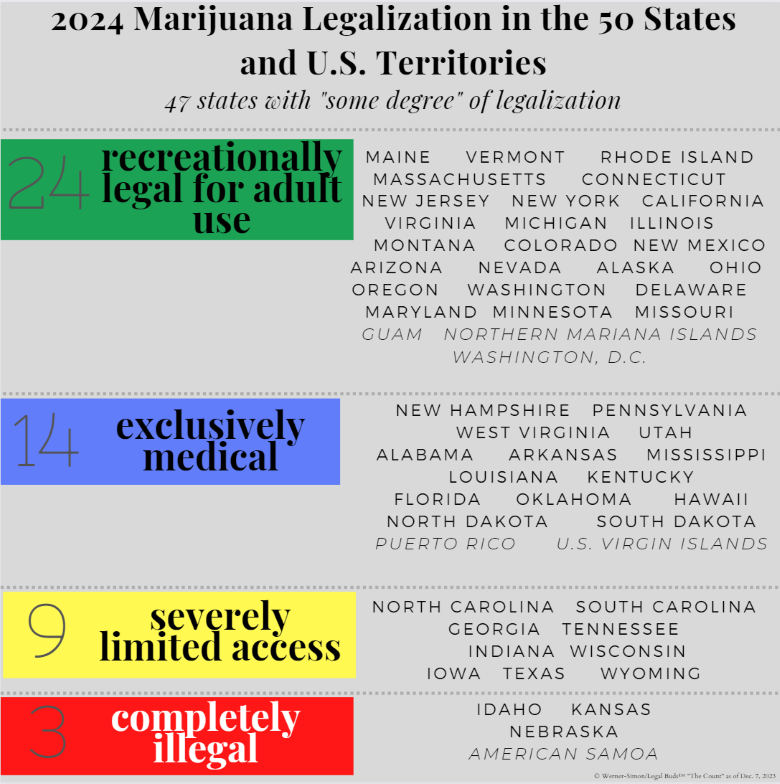
Julie Werner-Simon
More progress has happened on American cannabis legalization in the past three years than in the fifty before.
From May 1971 when President Richard Nixon’s Controlled Substances Act of 1970 became effective, which created the Drug Enforcement Administration (DEA) and federally criminalized cannabis (putting it in Schedule I of the federal drug schedule in the same banned drug category as heroin and LSD), to early 2021, (when the Biden administration starting approving applications to conduct cannabis research), the federal government was, for the most part, consistently anti-cannabis.
However, the Obama administration did issue policy memos to address the federal and state conflict on cannabis legalization—one in 2009 and the other in 2013—directing federal law enforcement to keep their hands off those in medically legal states (2009) and those in adult-use states (2013) who were complying with their states’ cannabis laws and rules.
But during the Trump administration, in 2018, Attorney General Jeff Sessions rescinded the Obama “be-soft-on-legal-states” memoranda, calling it a “return to the rule of law.”
50 Years of Little to No Progress
From March 1972, when President Nixon’s commission issued its report recommending that marijuana be decriminalized (which Nixon ignored) and continuing through the Trump administration— federally authorized scientific studies into cannabis were repeatedly blocked by the DEA.
And in the rare instances when a scientist was granted federal approval to conduct a scientific study into or with a Schedule I federally illegal drug, they were only authorized to conduct their studies with substandard cannabis provided to them by the federal government’s sole DEA-licensed cannabis grower at a university farm in Mississippi.
Finally, Federal Cannabis Game-Changers
Almost three years ago, there was a sea change. The Biden administration’s DEA started issuing multiple cannabis grower research agreements.
No longer would research be circumscribed, nor would researchers be required to study only the University of Mississippi’s marijuana. The DEA has expanded the number of research registrants permitting more researchers to both cultivate and study their own product.
As of March 2023, the DEA had approved seven bulk cannabis suppliers for cannabis research, operating in Arizona, Florida and Pennsylvania as well as three in California, in addition to the University of Mississippi.
Another game changer happened in Congress late in 2022, when the U.S. Congress with bipartisan support in the House and Senate, passed the Medical Marijuana and Cannabidiol Research Expansion Act.
The act aimed to expand cannabis research, to study its potential health benefits and to streamline the federal application process for scientific studies that have slowed the research process. President Biden signed the bill into law on Dec. 2, 2022.
Rapid change in the cannabis legal scene is also evidenced by President Biden’s federal marijuana possession pardon proclamation in October 2022, and his December 2023 expansion, which made more cannabis offenders eligible for federal pardons.
But the most cataclysmic change of the past three years was the Department of Health and Human Services (HHS) August 2023 Recommendation to the DEA to reschedule cannabis from Schedule I to Schedule III.
In December 2023, the DEA informed Congress that it was considering the HHS recommendation.
And the public first got to see the complete 252-page HHS re-scheduling report on Jan. 12, 2024 when the federal government, in response to a lawsuit, released it.
Some predict that sometime this year, the DEA will downgrade cannabis to Schedule III, and it will no longer be a federally illegal drug.
States Continue to Lead The Way
All this activity at the federal level remains dwarfed by the cascade of cannabis legalization occurring in the states and U.S. territories. With Ohio voters, in November 2023, legalizing adult recreational cannabis use and sale, Ohio became the 24th state to legalize adult use. The state legalization count and their degrees of legalization are constantly changing. It’s also likely that more states will change their degree of legalization in 2024.
Here is the count as of today:
- Recreationally Legal (with co-existing medical legalization): 24 states & 2 territories (Guam & the Northern Mariana Islands) & Washington, D.C, a federal district;
- Exclusively Legal for medical use: 15 states & 2 territories (Puerto Rico & the U.S. Virgin Islands);
- Severely Limited Access: 9 states.

U.S. Map Explanation:
(i) adult-use states with co-existing medical regimes, like California (green on the map);
(ii) exclusively medical legalization for a plethora of medical conditions treated by any amount of THC product, like Pennsylvania (in blue on the map) and
(iii) those states that provide severely limited access (SLA) – including some states that call themselves “medically legal” but only permit a lone class or a few categories of people (such as patients who prove that they have intractable epilepsy) to use reduced THC, limited amount of product and/ or only CBD products (yellow on the map).
As of February 2024, this leaves 47 states and four inhabited U.S. territories with varying degrees of permissive marijuana use. This equates to approximately 99% of the U.S, population of some 336 million inhabitants having some degree of state or territorial law permitting cannabis use.

Momentum Will Continue
2024 promises to be another year of great change for the cannabis industry in America.
Should the DEA follow the recommendation from the HHS, federal rescheduling (so long as the innovations of the legalized states are preserved) will help the industry.
Removing cannabis from Schedule I could open-up banking as cannabis will no longer be federally illegal (and federally insured banks will no longer need fear exposure to money laundering charges). It will create a path to profitability as the IRC Section 280E taxation disparity that prevents the industry from deducting normal and customary business expenses because it is an illegal drug will no longer apply. Rescheduling will finally expand federal trademark protection opportunities. And failing cannabis businesses will likely have more access bankruptcy protections – also largely denied because of federal illegality.
Plus, more federally authorized research will help a broader swath of cannabis patients and consumers. This, and the juggernaut of states embracing cannabis as a recreational commodity, will surely change the cannabis landscape. The momentum of the last three years is bound to continue.
Julie A. Werner-Simon, a former federal prosecutor, is a legal analyst on the emerging business of cannabis at Drexel University’s LeBow School of Business and law professor adjunct at University of Southern California’s Gould School of Law and Drexel University’s Kline School of Law where she teaches “Marijuana Cannabis Law: History, Effective Business Practices and Degrees of Legalization.”
Latest from Cannabis Business Times
- Agrify Corp., Nature’s Miracle Terminate Planned Merger Under Mutual Agreement
- 5 Tips to Go Beyond Custom Utility Rebates
- Green Horizons Opens Initial 100K Square Feet of Mega Cannabis Cultivation Facility in California
- Intercanopy Lighting Trials Show Compelling Increases in Cannabis Quality, Consistency
- Cannabis Industry Reacts to Biden’s Rescheduling Announcement
- As Predicted, 4/20 Sales Surged During Cannabis Industry Holiday Weekend
- DEA 2024 Report Focuses on THC Potency, Organized Crime, Youth Edible Consumption
- Nature's Miracle, Agrify Sign Definitive Merger Agreement





